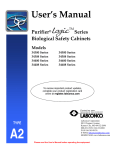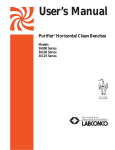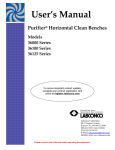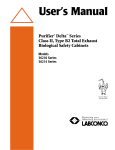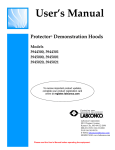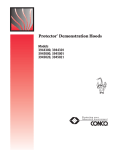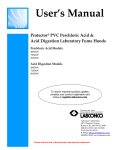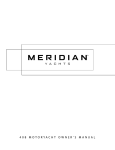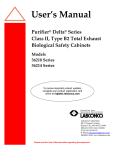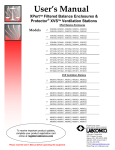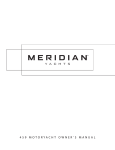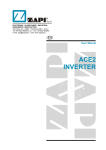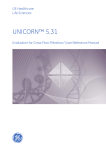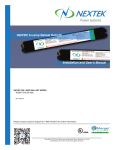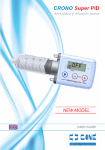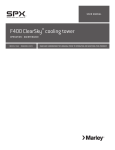Download 1300 Series B2 BSC - Operating Manual
Transcript
1300 Series B2 Class II, Type B2 Biological Safety Cabinet Operating Instructions 3848304 Rev. G Copyright These operating instructions are protected by copyright. Rights resulting thereof, particularly reprint, photomechanical or digital postprocessing or reproduction, even in part, are only allowed with the written consent of the Thermo Fisher Scientific Inc. This regulation does not apply to reproductions for in-plant use. Trademarks All trademarks mentioned in the operating instructions are the exclusive property of the respective manufacturers. Thermo Fisher Scientific Inc Controlled Environment Equipment 401 Millcreek Road, P.O. Box 649, Marietta, Ohio 45750-0649 United States Part #3848304, Rev. G ECO H795 Operating Instructions Safety Cabinet | 1300 Series B2 Contents CHAPTER 1: INTRODUCTION ........................................................................... 1 Instruction of the Operating Personnel ................................................................. 2 Warranty ............................................................................................................... 2 CHAPTER 2: PREREQUISITES .......................................................................... 3 Space Requirements ............................................................................................ 3 Suggested Location .............................................................................................. 4 Exhaust Requirements ......................................................................................... 5 Electrical Requirements........................................................................................ 5 Service Line Requirements .................................................................................. 6 CHAPTER 3: GETTING STARTED ..................................................................... 7 Unpacking the Biosafety Cabinet ......................................................................... 8 Moving the Cabinet .............................................................................................. 8 Preparing the Biosafety Cabinet for Operation ..................................................... 8 Installing the Biosafety Cabinet on an Existing Work Surface .............................. 8 Installing the Biosafety Cabinet on a Base Stand ................................................. 9 Telescoping Base Stands ..................................................................................... 9 Connecting the Biosafety Cabinet to Utility Service Lines .................................. 10 Exhaust System Connections............................................................................. 11 Exhaust System Requirements .......................................................................... 12 Drain Valve Installation ....................................................................................... 12 Initial Certification ............................................................................................... 13 CHAPTER 4: PERFORMANCE FEATURES AND SAFETY PRECAUTIONS .. 15 HEPA Filters ....................................................................................................... 15 ULPA Filters ....................................................................................................... 15 Laminar Airflow ................................................................................................... 17 Directional Airflow............................................................................................... 18 Motor/Blower ...................................................................................................... 19 Airflow Sensor .................................................................................................... 20 Cabinet Air Intakes (Grilles), Ductwork & Air Balance Controls .......................... 20 Ultraviolet (UV) Lamp ......................................................................................... 20 Safety Precautions ............................................................................................. 21 CHAPTER 5: USING THE CABINET ................................................................ 23 Correct Use ........................................................................................................ 23 Incorrect Use ...................................................................................................... 23 System Reset Switch ......................................................................................... 24 Information Center .............................................................................................. 24 Status Area......................................................................................................... 25 Performance Indicator ........................................................................................ 25 Icon Area ............................................................................................................ 25 Operating the Sliding Sash ................................................................................. 26 Starting the Biosafety Cabinet ............................................................................ 26 The Control Keypad ........................................................................................... 27 User Selectable Features ................................................................................... 32 Timer Operation ............................................................................................... 32 Interval Timer Operation ..................................................................................... 33 Stopwatch Timer Operation ................................................................................ 33 Menu Options ..... ............................................................................................... 33 UV Lamp Operation..................................................................................... 33 UV Lamp Timer ........................................................................................... 34 UV Lamp Maintenance ................................................................................ 34 Light Operation ............................................................................................ 34 Light Maintenance ....................................................................................... 35 Light Hourmeter .......................................................................................... 35 Change Light Life ........................................................................................ 35 Reset Light Clock ........................................................................................ 35 Blower Operation ........................................................................................ 35 User Preferences ........................................................................................ 35 If An Exhaust Error Activates.............................................................................. 37 If An Airflow Alert Activates ................................................................................ 37 Resetting the Airflow Alert System ..................................................................... 37 Working in the Biosafety Cabinet ....................................................................... 38 Operating Instructions Safety Cabinet | 1300 Series B2 Contents CHAPTER 6: MAINTAINING THE CABINET..................................................... 40 Routine Maintenance Schedule .......................................................................... 40 Service Operations ............................................................................................. 40 Work Surface Removal ................................................................................ 40 Front Grille Removal .................................................................................... 40 Towel Catch Removal .................................................................................. 41 Front Panel Removal ................................................................................... 42 Changing the B2 Prefilter ............................................................................. 43 Changing the Fluorescent Lamps ................................................................ 43 Changing the Optional UV Lamp ................................................................. 43 Resetting a Circuit Breaker .......................................................................... 44 Storage ............................................................................................................... 44 CHAPTER 7: TROUBLESHOOTING ................................................................. 45 APPENDIX A: COMPONENTS .......................................................................... 48 APPENDIX B: DIMENSIONS ............................................................................. 50 APPENDIX C: SPECIFICATIONS ...................................................................... 51 Motor Specifications ............................................................................................ 51 Environmental Conditions ................................................................................... 51 APPENDIX D: ACCESSORIES .......................................................................... 52 Telescoping Base Stands ................................................................................... 52 Seismic Bracket Kit ............................................................................................. 52 Service Valve Kit ................................................................................................. 52 Ultraviolet Lamp Kits ........................................................................................... 52 IV Bar Kits ........................................................................................................... 52 Backdraft Damper ............................................................................................... 52 ULPA Supply Filters ............................................................................................ 53 APPENDIX E: QUICK CHART ........................................................................... 54 DECLARATION OF CONFORMITY ................................................................... 55 Figures Figure 2-1 Figure 3-1 Figure 3-2 Figure 3-3 Figure 3-4 Figure 4-1 Figure 4-2 Figure 4-3 Figure 4-4 Figure 5-1 Figure 5-2 Figure 5-3 Figure 5-4 Figure 6-1 Figure 6-2 Figure 6-3 Figure 6-4 Figure A-1 Figure B-1 Preferred location for the Biosafety Cabinet ....................................... 4 Adjusting height of the base stand ...................................................... 9 Leveling the base stand .................................................................... 10 Connecting Biosafety Cabinet to service lines .................................. 11 Attaching drain assembly .................................................................. 13 HEPA filters ...................................................................................... 16 Downflow Velocity Profile ................................................................. 17 Inflow Volume or Average Inflow Velocity ......................................... 18 Motor/Blower recirculation ................................................................ 19 System reset switch .......................................................................... 24 Information Center LCD .................................................................... 24 Control Keypad ................................................................................. 27 Programming Menu Instructions ....................................................... 28 Front grille removal ........................................................................... 41 Towel catch removal ......................................................................... 42 Front panel removal ......................................................................... 42 Resetting a circuit breaker ................................................................ 44 Service parts/replacement accessory parts ...................................... 49 Dimensions ...................................................................................... 50 Operating Instructions Safety Cabinet | 1300 Series B2 1. Introduction Dear User, Congratulations on your purchase of a Thermo Scientific 1300 Series B2 Class II, Type B2 biosafety cabinet. Your 1300 Series B2 biosafety cabinet has been tested and certified in accordance to NSF/ANSI 49, and is designed to protect the user, the environment, and your research from harmful substances and cross-contamination. This user’s manual provides instructions on how to use the 1300 Series B2 most effectively and safely. The 1300 Series B2 offers a unique range of product features that will enhance your safety and improve overall operating efficiency. Should you have any questions on using this product or need further explanation of any of its features, please contact the Thermo Fisher Scientific technical support group at the phone numbers listed on the following pages. Postal address USA Thermo Fisher Scientific Inc. 401 Millcreek Road Marietta, Ohio 45750 Enquiries from North America, Latin America and Asia Pacific Phone Fax Email +1 888-213 1790 +1 740-373 4189 [email protected] 1 Operating Instructions Safety Cabinet | 1300 Series B2 1. Introduction Instruction of the Operating Personnel The operating instructions describe the safety cabinet 1300 Series B2, and applies to the models: • • 4-foot models 1310 / 1311 / 1315 / 1316 / 1317 / 1318 6-foot models 1360 / 1361 / 1362 / 1363 / 1364 / 1365 This safety cabinet has been manufactured in keeping with the latest technological developments and has been tested before delivery for its correct function. It may, however, present potential hazards if it is not used according to the intended purpose or outside of operating parameters. Therefore, the following procedures must always be observed to prevent accidents: • • • The safety cabinet should be operated by authorized personnel who have been trained on the use and maintenance of this product. For any operation of this device, it is recommended that the operator prepares clear and concise written instructions in the language of the operating and cleaning personnel based on these operating instructions, applicable safety data sheets, plant hygiene guidelines, and technical regulations. Most importantly: • which decontamination measures are to be applied for the cabinet and accessories, • which protective measures apply while specific agents are used, • which measures are to be taken in the case of an accident. To ensure safety during the repair of the cabinet, servicing of the equipment must be carried out by trained and authorized personnel. Warranty Thermo Fisher Scientific warrants the operational safety and functions of the safety cabinet only under the condition that: • • • • • the device is operated and serviced exclusively in accordance with its intended purpose and as described in these operating instructions, the device is not modified, only original spare parts and accessories that have been approved by Thermo Fisher Scientific are used, inspections and preventative maintenance are performed at the specified intervals, an installation certification is performed prior to the initial operation of the device and a repeat certification is performed on the occasion of all inspections and repairs. The warranty is valid from the date of delivery of the device to the operator. 2 Operating Instructions Safety Cabinet | 1300 Series B2 2. Prerequisites Before you install the Biosafety Cabinet, you need to prepare the site for installation. Carefully examine the location where you intend to install the cabinet. You must be certain that the area is level and of solid construction. In addition, a dedicated source of electrical power must be located near the installation site. Carefully read this chapter to learn: • Location requirements. • Electrical power requirements. • Exhaust requirements. • Service utility requirements. • Space requirements. Refer to Appendix C: Specifications, for complete biosafety cabinet electrical and environmental conditions, specifications and requirements. Space Requirements The dimensions for the different models are shown in Appendix B: Dimensions. 3 Operating Instructions Safety Cabinet | 1300 Series B2 2. Prerequisites Suggested Location Note: The Biosafety Cabinet should be located away from traffic patterns, doors, fans, ventilation registers, fume hoods and any other air-handling devices that could disrupt its airflow patterns. All windows in the room should remain closed. Figure 2-1 shows the preferred location for the Biosafety Cabinet. Preferred location Air register blocked or redirected to prevent cabinet disruption Figure 2-1 Alternate location 4 Operating Instructions Safety Cabinet | 1300 Series B2 2. Prerequisites Exhaust Requirements Before deciding on a location, examine it carefully to ensure that it is compatible with the cabinet’s exhaust duct. The area directly above the cabinet’s exhaust port should be clear of structural elements, water and utility lines, or other fixed obstructions. There should be enough clearance to allow for the passage of a 10" PVC or stainless steel duct. Avoid cabinet locations that require either an elbow directly on top of the cabinet’s exhaust connection or an excessive number of elbows to clear other items. For a further discussion of the cabinet’s exhaust system requirements, please go to Chapter 3: Getting Started. Electrical Requirements The different Biosafety Cabinet models have the following electrical requirements: Table 2-1 Model # 1310, 1311 1315, 1316, 1317, 1318 Requirements 115 VAC, 60 Hz, 12 Amps 230 VAC, 50/60 Hz, 6 Amps 1360, 1361 1362, 1363, 1364, 1365 115 VAC, 60 Hz, 12 Amps 230 VAC, 50/60 Hz, 6 Amps Note: A dedicated outlet with a circuit breaker should be located as close as possible to the right rear side of the cabinet, at a height even with, or higher than, the top of the bench or stand. 5 Operating Instructions Safety Cabinet | 1300 Series B2 2. Prerequisites Service Line Requirements All utility service lines should be ¼ inch O.D., brass, copper, or stainless steel, and equipped with an easily accessible shut-off valve. If the service line pressure exceeds 100 PSI, it must be equipped with a pressure regulator to reduce the line pressure. Consult local regulations for materials, pressures and techniques regarding gas services. Note: The use of flammable gases or solvents should be avoided in the Biosafety Cabinet. Open flame in the cabinet will disrupt the laminar airflow in the cabinet and may damage the HEPA filters. Flammable gases or solvents may reach explosive concentrations in the cabinet or ductwork. If you feel that the procedure requires the use of an open flame or flammable materials, contact the institution’s safety office. The use of air or gases under high pressure should be avoided as they may seriously disrupt the airflow patterns in the cabinet. 6 Operating Instructions Safety Cabinet | 1300 Series B2 3. Getting Started Now that the installation is properly prepared, you are ready to inspect, install, and certify the Biosafety Cabinet. This chapter covers how to: • Unpack and move the Biosafety Cabinet. • Install the cabinet. • Connect the electrical supply source. • Connect the service lines. • Connect to an exhaust system. • Arrange certification of the Biosafety Cabinet. Tools required for installation the Biosafety Cabinet include two 1/2" wrenches, a flat-blade screwdriver, a #2 Phillips screwdriver, and a carpenter’s level. Note: The Biosafety Cabinet models weigh between 400–700 lbs. (182-318 kg). The shipping pallet allows for lifting with a mechanical lift truck or floor jack. If you must lift the product manually, use at least six (6) persons and follow safelifting guidelines. Note: The side panels must be removed to access the fasteners that secure the Biosafety Cabinet to the pallet. DO NOT ATTEMPT TO LIFT THE BIOSAFETY CABINET BY THE SIDE PANELS; DAMAGE WILL OCCUR. 7 Operating Instructions Safety Cabinet | 1300 Series B2 3. Getting Started Unpacking the Biosafety Cabinet Carefully remove the outer carton and inspect the cabinet for damage that may have occurred in transit. If the Biosafety Cabinet is damaged, notify the delivery carrier immediately and retain the entire shipment intact for inspection by the carrier. Note: United States Interstate Commerce Commission rules require that claims be filed with the delivery carrier within fifteen (15) days of delivery. Do not return goods without the prior authorization of Thermo Fisher Scientific. Unauthorized returns will not be accepted. If the cabinet was damaged in transit, you must file a claim directly with the freight carrier. Thermo Fisher Scientific is not responsible for shipping damages. Do not discard the carton or packing material for the Biosafety Cabinet until all of the components have been checked, installed and tested. The cabinet is secured to the pallet in two places on each side. To access the nuts and bolts, remove the side panels by removing and keeping the two Phillips screws on both panels. Swing the front of each panel away from the Cabinet, and lift it straight up to remove the panel from the cabinet. Moving the Cabinet Move the cabinet, attached to its pallet, by using a floor jack, or a furniture dolly underneath the unit. DO NOT move the cabinet by tilting it onto a hand truck. Preparing the Biosafety Cabinet for Operation Installation instructions for the cabinet are attached to the sash of the Biosafety Cabinet. If these instructions are missing or unclear, contact Product Service at 1-888-213-1790. Installing the Biosafety Cabinet on an Existing Work Surface Note: The Biosafety Cabinet is very top heavy. Use caution when lifting or moving it. When installing the Biosafety Cabinet onto an existing work surface or benchtop, ensure that the structure can safely support the combined weight of the cabinet and any related equipment. The work surface should be at least as wide as the Cabinet and 31 inches (787 mm) deep to properly support the unit. A hole or notch may be cut in the supporting surface in the right front corner to accommodate the drain valve. 8 Operating Instructions Safety Cabinet | 1300 Series B2 3. Getting Started Installing the Biosafety Cabinet on a Base Stand Thermo Scientific offers accessory Base Stands that effectively support the weight of the cabinet. Stands for a B2 cabinet generally are not mobile, since it is connected to an exhaust duct. Telescoping Base Stands Adjust the leg height before installing the cabinet on top of the stand. The height can be set in 1-inch intervals between 27.5 to 34.5 inches (699 to 876 mm), providing a Cabinet work surface height from 30.0 to 37.0 inches (762 to 940 mm). The Base Stands for each width Cabinet are listed in Table 3-1 below. Table 3-1 Width 4' 6' Base Stand w/Feet Model # 3730402 3730602 1. Before positioning the Telescoping Base Stand in its final location, adjust the height. A plastic bag containing the mounting bolts for the Biosafety Cabinet is shipped with the base stand. Remove and save it. 2. Select the height of the stand and slide four (4) leg extensions into base stand corner posts and attach with 2 ¼ inch long bolt, flatwasher, lockwasher and nut. Ensure that the same height hole is selected for each leg. Tighten the leg bolts securely. See Figure 3-1. Figure 3-1 9 Operating Instructions Safety Cabinet | 1300 Series B2 3. Getting Started 3. CAUTION: Only lift and support the cabinet at the stainless steel sides and back. Damage will occur if lifted or supported on the front edge. Move the base stand into its final location. Using a carpenter’s level, adjust each leveling foot until the stand is level in both planes as shown in Figure 3-2. You are now ready to lift the Biosafety Cabinet onto its stand. Figure 3-2 Connecting the Biosafety Cabinet to Utility Service Lines The service lines (if any) should be connected to the tube fitting(s) on the outside of the liner wall as shown in Figure 3-3. To install the tubing, follow these steps: 1. Ensure that the tubing is ¼ inch O.D., soft metal, and that the end has been completely deburred. 2. Route the tubing from the rear of the cabinet, ensuring that it will line up with the slot in the back of the side panel. The slot is located from 8.75 to 11.25 inches (222 to 288 mm) from the bottom of the cabinet. Note: Make sure that the tube routing will not contact any electrical wires. DO NOT loop service line tubing within the side panels of the Cabinet. 10 3. Make sure that the nut on the tube fitting is loose, but do not remove it. Look inside the fitting to make sure the tube ferrule is there. 4. Push the tube into the fitting until it is properly seated. The tube will go approximately ¾ inch (19 mm) into the fitting. Operating Instructions Safety Cabinet | 1300 Series B2 3. Getting Started 5. Tighten the tube fitting nut hand tight and then, using a 7/16-inch wrench, tighten it at least ¾ turn more. 6. Close the service valve in the Biosafety Cabinet and then slowly open the shutoff valve on the service valve. Test all fittings for leakage. Tighten the tube nut slightly if needed. Figure 3-3 Tube fitting nut Tube fitting Seal fittings to cabinet with silicone sealant Exhaust System Connections The Total Exhaust Biosafety Cabinets are a “Type B2 cabinet,” meaning they direct their HEPA filtered exhaust air out of the laboratory. Note: The B2 Biosafety Cabinet is designed to be connected to an appropriate exhaust system. Do not attempt to operate it when it is not connected to an appropriate exhaust system. THE EXHAUST CONNECTION IS A SEALED EXHAUST SYSTEM FROM THE TOP OF THE CABINET TO THE REMOTE BLOWER. THE EXHAUST SYSTEMS SHOULD BE DEDICATED TO A SINGLE CABINET. THE CABINET IS EQUIPPED WITH AN EXHAUST FLOW ALARM, SUCH THAT AN ALARM SOUNDS, AND THE CABINET BLOWER SHUTS OFF IN THE EVENT OF INSUFFICIENT EXHAUST FLOW. If your research involves the use of toxic compounds or volatile materials, contact your facility’s safety officer or Thermo Fisher Scientific to ensure that your cabinet and its exhaust system are compatible with the materials you will be working with. 11 Operating Instructions Safety Cabinet | 1300 Series B2 3. Getting Started Exhaust System Requirements The cabinet exhaust stack is sized to accept 10-inch (254 mm) stainless steel ductwork. The exhaust system’s blower should be sized to handle the sum of: 1) The pressure loss for the building’s exhaust system (duct work) when it operates at the Cabinet’s flow rate. 2) PLUS The initial operating loss of the cabinet (1.0 inches (25 mm) of water for the 1310 through 1318 Series B2 cabinets, OR 1.4 inches (36 mm) of water for the 1360 through 1365 Series B2 cabinets. 3) PLUS, In order to get the maximum possible life out of the cabinet’s exhaust filter, the system should be able to draw an additional 2.0 inches (51 mm) of vacuum. EXAMPLE A 1310 Series Cabinet is being connected to an exhaust system that has a calculated loss 0.5 inches of water when operating at the Cabinet’s required flow rate of 810 CFM. What should the design capacity of the system be? ANSWER + + = 0.5” Exhaust system loss 1.0” Initial Cabinet loss 2.0” Reserve for maximum exhaust filter life 3.5” Vacuum total at maximum load NOTE: The exhaust system should be fitted with a backdraft damper (part #3858800) to prevent the reversing of airflow in the system. Drain Valve Installation In order to prevent damage during shipping, the drain valve assembly has not been installed. It is not required, but if desired, the valve should be installed after the Cabinet is in its final location. To install the valve assembly, follow these steps: Note: The work surface is heavy. Use caution when handling it. 12 1. Lift the work surface out of the Biosafety Cabinet by lifting on the knobs at the front of the work surface. Steady the work surface while pulling it straight out the front of the cabinet. 2. Using a putty knife, remove and discard the stainless steel cover that is sealed over the drain mounting holes. Scrape out remaining sealant that is around the holes. 3. Apply a light coating of silicone sealant (user supplied) to the mounting surface of the drain assembly. Attach the drain assembly under the bottom of the cabinet as shown in Figure 3-4. Wipe off any excess sealant from the cabinet bottom. Ensure that the center drain hole is unobstructed. 4. Make sure the drain valve is in the closed position. 5. Reinstall the work surface. 6. Allow the silicone sealant to cure for at least eight hours before exposing it to liquid. Operating Instructions Safety Cabinet | 1300 Series B2 3. Getting Started Figure 3-4 NOTE: If desired, the drain valve assembly attaches to the underside of the cabinet bottom. Apply a light coat of silicone sealant to this surface of the connector, aligning the three holes in the connector with the three holes in the Biosafety Cabinet liner. Initial Certification Prior to use, a qualified certifier should certify all Biosafety Cabinets. Under normal operating conditions, the Biosafety Cabinet should be recertified at least annually and when relocated or serviced. The certifier should perform the following tests, as recommended in ANSI/NSF International Standard Number 49 in effect when the cabinet was manufactured: • Downflow Velocity Profile Test • Inflow Velocity Test • Airflow Smoke Patterns • HEPA Filter Leak Test 13 Operating Instructions Safety Cabinet | 1300 Series B2 3. Getting Started • Site Installation Assessment Tests • Vibration Test * • Noise Level Test * • Lighting Intensity Test * *These tests are user comfort related tests and may be omitted at the user’s or certifier’s discretion. If you have any questions regarding certification agencies or need assistance in locating one, contact Thermo Scientific at 1-888-213-1790. NOTE! Service with costs: Unless certification was expressly called for in the specification, quotes and/or purchase order, the cost for this on-site testing is to be paid for by the customer. 14 Operating Instructions Safety Cabinet | 1300 Series B2 4. Performance Features and Safety Precautions All 1300 Series B2 Biosafety Cabinets operate using the following principles: • Filtration and retention of particulates by High Efficiency Particulate Air (HEPA) filter(s) • Laminar airflow • Directional airflow The major components in a Biosafety Cabinet are: • The HEPA or optional ULPA filter(s) • The motor/blower to force air through the Cabinet • Cabinet air intakes (grilles), ductwork and air balance controls HEPA Filters HEPA filters are disposable, dry-type particulate filters. The filter material or media is typically made of borosilicate microfibers formed into a thin sheet, in a process similar to the production of paper. This sheet is folded, or pleated to increase its surface area. The pleats are held in place by aluminum diffusers or by beads of glue that add rigidity to the media pack. The pack is then set into a frame, and sealed as shown in Figure 4-1. The HEPA filter manufacturer establishes the efficiency of the filter by challenging it with an aerosol of known particle size. The number of particles that penetrate the filter are quantified, and this establishes the efficiency of the filter. Thus, the filters used in the Thermo Scientific 1300 Series B2 Cabinets are at least 99.99% efficient in removing particles 0.3 micron. Note: The HEPA filter media is very fragile. DO NOT touch the media. If you think the media of a HEPA filter is damaged, DO NOT USE THE CABINET. Have the HEPA filter integrity tested by a certifier before using the cabinet. Note: HEPA Filters are only effective against particulate material. Gases will pass through the filter. ULPA Filters ULPA filters have the same properties as the HEPA filters described above except ULPA filters are rated at 99.999% efficient in removing particles 0.1-0.2 or 0.2-0.3 micron. 15 Operating Instructions Safety Cabinet | 1300 Series B2 4. Performance Features and Safety Precautions Figure 4-1 Filter frame Polyurethane seal between media pack and filter frame Filter media pack – A continuous sheet of filter media 16 Operating Instructions Safety Cabinet | 1300 Series B2 4. Performance Features and Safety Precautions Laminar Airflow Laminar airflow is defined as the movement of a body of air in a single direction, with a uniform velocity. In practice, the laminar downflow of air in the cabinet captures any aerosol generated in the work area of the cabinet, and directs it to the HEPA filters. In order to be true laminar downflow, a number of individual downflow velocity test points (The Downflow Velocity Profile) must be +/- 16 feet per minute (0.08 m/s) of the average of all the test points. This is illustrated in Figure 4-2. Figure 4-2 17 Operating Instructions Safety Cabinet | 1300 Series B2 4. Performance Features and Safety Precautions Directional Airflow Directional airflow also plays a key role in biosafety cabinet performance. Air is drawn into the front of the cabinet at the front grille. This “curtain” of air makes it more difficult for aerosols to escape out of the work area of the cabinet and into the outside environment. This airflow is often calculated and referred to as the Inflow Volume or Average Inflow Velocity. This is illustrated in Figure 4-3. Figure 4-3 18 Operating Instructions Safety Cabinet | 1300 Series B2 4. Performance Features and Safety Precautions Motor/Blower The motor/blower assembly pulls air into the top of the cabinet, and pushes air down through the supply HEPA filter, which then flows down through the work area. The external exhaust pulls the airflow into the front of the cabinet and from the supply filter through the exhaust filter and out of the building. The motor in the Thermo Scientific 1300 Series B2 Cabinet is an electronically commutated motor (ECM). The ECM is a brushless DC motor that includes its own power supply to convert the incoming alternating current to direct current, as well as its own microprocessor to control and measure the motor’s operation. The motor is preprogrammed to deliver a consistent volume of air, even as the filter loads over time. Figure 4-4 19 Operating Instructions Safety Cabinet | 1300 Series B2 4. Performance Features and Safety Precautions Airflow Sensor An airflow sensor, located above the Exhaust HEPA filter, constantly monitors the flow of exhaust air out of the cabinet. If the exhaust falls below a safe level, the control board turns off the cabinet blower, and sounds an audible and visual alarm. This prevents the escape of hazardous material from the front of the cabinet, in the event of an exhaust system failure. The airflow sensor reading is shown on the display as Inflow in feet per minute (or m/s). Cabinet Air Intakes (Grilles), Ductwork and Air Balance Controls The location, size, and pattern of the grilles at the front and rear of the work area affect cabinet containment and performance. Note: Never block or obstruct the grilles of the Biosafety Cabinet. The internal ductwork of the Biosafety Cabinet conveys the air from the top of the cabinet to the blower, and then from the blower to the supply filter. The positive pressure rigid plenum of the Biosafety Cabinet is designed to deliver a more uniform airflow to the supply HEPA filter, optimizing filter loading and operational life. Ultraviolet (UV) Lamp The optional UV lamp generates a primary wavelength of light of 254nm. A secondary emission is in the visible (blue) wavelength, resulting in the characteristic blue color while operating. UV light with a wavelength of 254 nm is biocidal, primarily by creating thymine dimers in DNA. These dimers prevent the correct transcription of the DNA into RNA, resulting in cellular death or viral inactivation. In order to be effective, the UV light must directly strike the nucleic acid, and its effectiveness can be diminished or negated by dissolved proteins or metals, or by other UV-opaque substances protecting the target nucleic acid. Because of its limitations, UV light should be used as an adjunct to good surface disinfection practices. In order to get optimum performance from the UV light, it should be replaced after 6,000 hours of operation or less, and the exterior surface of the lamp should be kept clean and free of dust. Note: The Cabinet records the number of hours of operation of the UV light. You can program in the number of hours (in 100-hour increments) it will operate before a replacement message is displayed. Note: UV irradiation is absorbed by the tempered safety glass of the sash. Independent research has shown that the level of UV irradiation on the outside of the cabinet’s sash is equal to background radiation levels. Note: The UV sensitivity of a target organism varies, depending on the UV output of the lamp, the genus and species of the organism, the medium the agent is suspended in, etc. Contact the facilities Health and Safety Officer at your facility for UV light use and recommendations. 20 Operating Instructions Safety Cabinet | 1300 Series B2 4. Performance Features and Safety Precautions Safety Precautions WARNING: The Biosafety Cabinet should be certified by a certification technician before its initial use. The cabinet should be recertified whenever it is relocated, serviced or at least annually thereafter. Do not assume that filter integrity and airflow performance have not been compromised during shipment. Some internal components of the Biosafety Cabinet may become contaminated during operation of the unit. Only experienced personnel competent in decontamination procedures should decontaminate the cabinet before servicing these components. If you have any questions regarding certification agencies, or need assistance in locating one, contact Thermo Fisher Scientific. Ensure that the Cabinet is connected to electrical service in accordance with local and national electrical codes. Failure to do so may create a fire or electrical hazard. Do not remove or service any electrical components without first disconnecting the Biosafety Cabinet from electrical service. Avoid the use of flammable gases or solvents in the Biosafety Cabinet. Care must be taken to ensure against the concentration of flammable or explosive gases or vapors. An open flame should NOT be used in the Biosafety Cabinet. Open flames will disrupt airflow patterns in the cabinet, burn the HEPA filter and/or damage the filter’s adhesive. Gases under high pressure should not be used in the Biosafety Cabinet, as they may disrupt its airflow patterns. HEPA filters only remove particulate matter. Operations generating volatile toxic chemicals or radionuclides must be evaluated carefully. The media of HEPA filters is fragile and should not be touched. Avoid puncturing either HEPA filter during installation or normal operation. If you suspect that a HEPA filter has been damaged, DO NOT use the cabinet; contact a local certification provider. The HEPA filters in the Biosafety Cabinet will gradually accumulate airborne particulate matter from the room and from work performed in the cabinet. The rate of accumulation will depend upon the cleanliness of the room air, the operating time and the nature of work being done in the cabinet. The Performance Indicator accurately displays the amount of filter life remaining. Proper operation of the cabinet depends largely upon its location and the operator’s work habits. Consult the Installation and Normal Operation sections of this manual for further details. Avoid direct exposure of plastic or coated materials to ultraviolet (UV) radiation. Never bypass the UV safety interlock that only allows the UV light to work when the sash is closed. 21 Operating Instructions Safety Cabinet | 1300 Series B2 4. Performance Features and Safety Precautions When surface disinfecting the Biosafety Cabinet: • Avoid splashing the disinfecting solution on skin or clothing. • Ensure adequate ventilation. • Carefully follow the disinfectant’s safety instructions. • Always dispose of disinfecting solutions in accordance with local and national laws. • DO NOT allow disinfectants with high concentrations of free chlorine to contact the stainless steel components of the Biosafety Cabinet for a long period of time. Free chlorine will corrode stainless steel after extended contact. The electrical receptacle cover may be removed to facilitate surface decontamination. Biosafety Cabinets should be decontaminated for any of the following reasons: 22 • Before maintenance work requiring entry into contaminated areas. • Before exhaust HEPA filter changes. • Before performing certification tests requiring entry into contaminated areas. • Before relocating the cabinet. • Before changing research programs. • After the gross spill of biohazardous material or toxic chemicals. Operating Instructions Safety Cabinet | 1300 Series B2 5. Using the Cabinet Correct Use The biosafety cabinet is a laboratory device for installation and operation in microbiological and biotechnical laboratories of safety levels 1, 2, and 3. It has been designed as a Class II safety cabinet, Type B2, in accordance with NSF/ANSI, Standard 49/2004. Depending on the hazard level of the agents involved, the operator must prepare in writing appropriate decontamination procedures for the device and the accessories used in the sample chamber. Prior to the initial operation of the cabinet, the operator must perform an installation test, or certification. According the NSF, the test result must be documented by a test report. The cabinet must only be used after it is in compliance with the operating parameters as specified by Thermo Fisher Scientific. After any changes to the installation conditions and after any modification to the technical system, the certification test must be repeated and the test result must be documented in a way that demonstrates all operating parameters are in compliance with those specified by Thermo Fisher Scientific. Incorrect Use To ensure optimum safety to the user and the environment, the safety cabinet should not be used in laboratories that do not comply with the requirements of safety levels 1, 2 or 3. The device must not be operated as a Class II, Type B2 safety cabinet if: • no repeat test is performed after changes to the installation conditions or after modifications to the technical system, • the alarm system of the device has issued a failure message and the cause for the failure has not been repaired. The alarm system must not be tampered with or disabled. If alarm system components have been removed or disabled for service or repairs, the device must only be released for operation after all alarm system components are confirmed to be functioning properly. The HEPA filters installed in this biosafety cabinet are designed to be excellent capture devices for particulate matter to a diameter of 0.3 um. HEPA filters are not capable of separating gaseous substances. Therefore, avoid storing or processing gases or gas-releasing substances in the device: • which in quantity or concentration are toxic, • if a reduction with other substances may result in hazardous toxic concentrations or formation of toxic gases, • that may form combustive or explosive mixtures in combination with air. 23 Operating Instructions Safety Cabinet | 1300 Series B2 5. Using the Cabinet System Reset Switch The Biosafety Cabinet has a system reset switch for resetting its microprocessors. The switch is located on the front of the electronics module, on top of the Cabinet, as shown in Figure 5-1. Ensure that the switch is in the “ON” (up) position before attempting to operate the Cabinet. Figure 5-1 The System Reset Switch Information Center The Information Center is an LCD display located on the right side wall at eye level. The center’s display is divided into three separate areas, as shown in Figure 5-2, below. The display will turn itself off one minute after turning off the blower or closing the sash. Figure 5-2 Status Area Performance Indicator Icon Area Measured Air Inflow 24 Operating Instructions Safety Cabinet | 1300 Series B2 5. Using the Cabinet Status Area The Status Area displays the system’s condition during operation. This line can display any of the following messages: Sash is too high The sash is open too far for safe operation. Please Wait Good practices should allow the blower to run at least three minutes to clean the air within the cabinet. Airflow Alert The airflow patterns in the cabinet have changed, resulting in a sudden change in the motor speed. This is most likely due to a blockage of the prefilter (if applicable). Exhaust Error There is insufficient exhaust airflow for the cabinet to operate safely. Pressing the “Blower” button will restart the blower. If there is still insufficient airflow, the alarm will sound again. IF THE CABINET KEEPS GOING INTO EXHAUST ERROR, DO NOT USE THE CABINET UNTIL THE PROBLEM HAS BEEN CORRECTED. System Error The motor and display circuit board are not communicating properly. DO NOT USE THE CABINET UNTIL THE PROBLEM HAS BEEN CORRECTED. Performance Indicator The bar graph represents the capacity of the system. When new filters are in the 1300 Series B2 Biosafety Cabinet, the Performance Indicator should read approximately 100%. Over time, the filters will load and reduce the available capacity. The cabinet will continue to deliver the proper airflows while the Performance Indicator monitors the ability of the blower to overcome the filter loading. Various factors such as temporary obstructions to airflow, temperature and barometric pressure can cause the displayed percentage to vary slightly. Ignore short term changes in the Performance Indicator’s value. As the Performance Indicator approaches 20% remaining capacity, consider having the cabinet filters replaced. Icon Area The Icon Area displays icons for those features selected or in operation. The Icons are: Normal blower operation – In this mode the cabinet blower is operating normally. 25 Operating Instructions Safety Cabinet | 1300 Series B2 5. Using the Cabinet Fluorescent light In this mode the fluorescent lights are operating. When the sash is fully closed, the fluorescent lights automatically turn off. UV light In this mode the UV (germicidal) light is operating. When the sash is fully closed, the UV light can be programmed to automatically turn on. When the sash is raised, the light automatically turns off, to protect the laboratory from UV irradiation. Timer When either the interval or stopwatch timer mode is active, this icon appears. Security Lock When the security lock is activated the keypad does not respond to any buttons until the proper sequence of keystrokes is entered. Mute When this icon is on, the audible alarm is muted for approximately 5 minutes. Operating the Sliding Sash The counterbalanced, anti-racking sash mechanism requires only a few pounds of force to move the sash up or down. You can open or close the sash smoothly with one or two hands positioned on either handle. The sash position alarm and safety interlock system senses the sash position and acts appropriately. The Biosafety Cabinet has been programmed to operate at an 8-inch (203 mm) sash opening, depending on model. Raising the sash above its operating height will activate the audible and visual alarms. The audible alarm can be temporarily muted (for approximately five minutes) by depressing and releasing the Mute/OK button. Closing the sash back to its operating position will reset the alarm and defeat the muting of the alarm. The safety interlock system senses when the sash is closed and allows the optional ultraviolet (UV) lamp to operate only when the sash is closed, to protect the operator from irradiation. Starting the Biosafety Cabinet 1. 2. 26 To start the Biosafety Cabinet, raise the sash until its bottom edge aligns with the sash position label on the left corner post. Press the blower button to start the unit. The unit will run a self-test for approximately 15 seconds. Additionally, you will be instructed to “Please Wait” for three minutes to allow the cabinet to reach proper operating conditions. If the display shows “sash is too high” and the alarm sounds, recheck the sash position. If the display shows “exhaust error”, the cabinet blower will shut off, and the audible alarm will sound. Pressing the blower button again will restart the unit for 15 second, after which, the 1300 Series B2 Cabinet will again check the exhaust airflow. IF THE CABINET KEEPS GOING INTO EXHAUST ERROR, DO NOT USE THE CABINET UNTIL THE PROBLEM HAS BEEN CORRECTED. Operating Instructions Safety Cabinet | 1300 Series B2 5. Using the Cabinet 3. To turn the UV light on, the sash must be completely closed to prevent the escape of any UV radiation. Push the UV light button to activate the UV light. Note: The sash must be completely closed for the UV light to activate. The Control Keypad Figure 5-3 The touchpad of the 1300 Series B2 Cabinet is shown in Figure 5-3. Take a moment to get familiar with the buttons, their location and function. Also familiarize yourself with the display located on the right side wall. The display will report system functions, such as filter capacity, timer displays, alarm or error messages, as well as icons that illuminate when cabinet functions such as UV light and blower are operational. Blower Button – Starts or stops the cabinet blower. When the blower is in Auto Start mode, closing the sash turns the blower off. When the sash is raised, the blower restarts automatically. Pressing this button overrides the Auto Start operation. Light Button – Turns the fluorescent lamps on or off. Closing the sash automatically turns the lights off. When the lights are in Auto Start mode, raising the sash turns the lights on automatically. UV Light Button – Turns the UV lamp on or off. When the UV lamp is in Auto Start mode, closing the sash turns the light on. When the sash is raised, the light turns off automatically. Timer Button – Allows you to select either a repeating interval timer, or an elapsed timer (stopwatch). Mute/OK Button – Mutes all audible alarms for approximately 5 minutes, unless it is a system error alarm. When in the Menu mode, this button is used to select an option. Menu Button – This button toggles the display between the display and menu modes. When in the menu mode, pressing this button returns you to the previous menu level. Select Buttons – Allow you to choose different options in the menu mode. 27 Operating Instructions Safety Cabinet | 1300 Series B2 5. Using the Cabinet Figure 5-4 28 Operating Instructions Safety Cabinet | 1300 Series B2 5. Using the Cabinet 29 Operating Instructions Safety Cabinet | 1300 Series B2 5. 30 Using the Cabinet Operating Instructions Safety Cabinet | 1300 Series B2 5. Using the Cabinet 31 Operating Instructions Safety Cabinet | 1300 Series B2 5. Using the Cabinet User Selectable Features The Thermo Scientific 1300 Series B2 Biosafety Cabinet offers the user unparalleled flexibility and convenience. The operation of the blower, fluorescent and UV lights can either be operated manually, or you may choose to use the Auto Start feature that activate functions automatically when the sash is opened or closed. The UV lamp can be programmed to operate for a given time interval when the sash is closed, before it shuts off. NOTE: During the first fifteen seconds of operation, the Cabinet performs an auto-diagnostic routine to check the operation of the microprocessor. You cannot access the menu during this time. NOTE: When you are in the menu mode, if a selection is not made within 30 seconds, the display will reset back to display mode. NOTE: Pressing the appropriate touchpad button will override Auto Start selections. To access the menu, press the “MENU” button. The display panel will show the first level menu. To select from the various menu options press the “▲” or “▼” buttons until the selected option is displayed. Press “OK” to accept that option, or press “MENU” to return to the previous menu level. Timer Operation NOTE: The timer button allows activation of an interval (countdown) or stopwatch (elapsed) timer. The timers cannot be operated simultaneously. To access the main timer menu, press the “Timer” button anytime during normal operation. The main timer menu is shown on the LCD display. Use the “▲” and “▼” buttons to highlight the Interval or Stopwatch Timer. Press the “OK” button to select the highlighted timer function. 32 Operating Instructions Safety Cabinet | 1300 Series B2 5. Using the Cabinet Interval Timer Operation 1. When selected, the Interval Timer menu is displayed on the LCD. The timer defaults to 0:00:00 (hours:minutes:seconds). 2. Press and hold the “▲” or “▼” buttons to increase or decrease the timer interval. 3. When the proper interval is entered on the display, press the “OK” button to start the timer. 4. When the timer reaches 0:00:00, an audible alarm will sound, and the timer will reset itself and repeat the countdown. 5. Press the “OK” button to pause the timer. 6. Press the “Menu” button to clear the interval timer and return to the main timer menu. Stopwatch Timer Operation 1. When selected, the Stopwatch Timer menu is displayed on the LCD. The timer defaults to 0:00:00. 2. Press the “OK” button to start the timer. 3. Press the “OK” button again to zero the timer. 4. Press the “Menu” button to clear the stopwatch timer and return to the main timer menu. Menu Options UV Lamp Operation This menu option allows you to select whether the UV light will turn on automatically every time the sash is completely closed. Auto Start When the “Auto Start” option is selected, the UV light will turn on every time the sash is closed. Manual Operation When the “Keypad Controlled” option is selected, the UV light must be turned on and off at the keypad. 33 Operating Instructions Safety Cabinet | 1300 Series B2 5. Using the Cabinet UV Lamp Timer The UV Lamp Timer allows you to decide whether the UV lamp will operate continuously or for a time period that you select. Interval When the “Operating Time” option is selected, the UV Operating Time menu is displayed. UV Operating Time This window lets you set the amount of time the UV lamp stays lit when activated. Use the “▲” and “▼” buttons to select the amount of time you need, then press the “OK” button to set the interval. NOTE: Raising the sash will reset the timer to its original setting. Pressing “UV Light” will turn the light off, pressing “Mute/OK” will pause the timer. Continuous In the continuous mode, the UV light will remain lit until the “UV Light” button is pressed, or the sash is raised. UV Lamp Maintenance This selection allows you to check how many hours the UV lamp has burned. It also allows you to set the number of hours you want the lamp to last, and to reset the UV lamp hourmeter. UV Lamp Hourmeter This display only shows how many hours the UV lamp has been lit, and how many hours remain until you will receive a warning to replace the lamp. Set UV Lamp Life In this option, you can set the number of operating hours before receiving the replace UV lamp warning. For most UV lamps, the output of UV light decreases at a constant rate. Typically, after 6,000 hours of operation the lamp will output 80% of the UV light it did when it was new. This option allows you to set the warning at a life you prefer, in 100 hour increments. Reset UV Lamp Clock This option lets you reset the UV hourmeter to 0 whenever the lamp has been replaced. Light Operation This menu option allows you to select whether the fluorescent lights will turn on automatically every time the sash is opened. NOTE: The fluorescent lights will automatically turn off when the sash is closed, no matter what its setting is. Auto Start When the “Auto Start” option is selected, the fluorescent lights will turn on every time the sash is opened. 34 Operating Instructions Safety Cabinet | 1300 Series B2 5. Using the Cabinet Manual When the “manual touchpad” option is selected, the fluorescent lights must be turned on and off at the touchpad. Light Maintenance This selection allows you to check how many hours the fluorescent lamps have burned. It also allows you to set the number of hours before replacement and to reset the light hourmeter. Light Hourmeter This display only shows the hours the fluorescent lamps have been lit and how many hours remain until you receive a warning to replace the lamps. Change Light Life In this option, you can set the hourmeter before you get the replace light warning. For most fluorescent lamps, the output of light decreases at a constant rate. Typically, after 6,000 hours of operation the lamp will output less light than it did when it was new. This option allows you to set the warning at whatever level you prefer, in 100 hour increments. Reset Light Clock This option resets the light hourmeter to 0 after the fluorescent lamps have been replaced. Blower Operation This selection allows you to choose to operate the blower in Auto Start or Keypad Controlled modes. Auto Start When the “Auto Start” option is selected, the blower will turn on every time the sash is opened. When the sash is closed, the blower will shut off. Manual Touchpad When the “Manual Touchpad” option is selected, the blower must be turned on and off at the touchpad. User Preferences These selections allow for the customization of the display and the cabinet operation. Units of Measure This option allows you to select the air velocity units of measure. When “Metric” is selected, the air velocities will be displayed in meters-persecond. When “US” is selected, the velocities will be displayed in feet-persecond. Security Code NOTE: The security code feature automatically reactivates and locks out the keypad every time the blower is shut off, by the keypad or by closing the sash. After the initial auto diagnostic screen is cleared, the security lock reactivates. 35 Operating Instructions Safety Cabinet | 1300 Series B2 5. Using the Cabinet The security lock feature prevents operation of the Biosafety Cabinet by unauthorized users. To engage the security lock, access the Security Lock submenu, as described in Figure 5-4. Select the “secure” option, and press the “OK” button. A ‘lock’ icon appears on the LCD display. Once engaged, the operator must enter the proper sequence of keystrokes to operate the cabinet. The proper sequence to unlock the Security Lock is: Press the “▼” keypad 3 times within 2 seconds. After successful entry of the unlock code, the lock icon disappears from the display, and the user has full access to the keypad functions. To disable the Security Lock, enter the Security Code submenu and select the non-secure mode. The lock is completely disabled. Data Output Rate Note: This selection will only work if the optional RS-232 board is installed. This menu option selects the rate that the RS-232 board outputs data. Data can be output at a rate of once per second, once every 10 seconds, once every 30 seconds, or once per minute. Restoring Software Default Settings To restore the default settings to the following configuration: 1. 2. 3. Access the Menu, and select “User Preferences”. Press “Mute/OK” In the User Preferences submenu, select “Restore Defaults”. Press “Mute/OK” Press “Mute/OK” again to restore the software defaults. Pressing “Menu” will escape this submenu without restoring the defaults. Table of Default Settings UV Lamp: Auto Start, Continuous, Reset UV Lamp Hourmeter, UV Lamp Life at 6000 hrs. Blower: Auto Start Units of Measure: Ft / Min Security Lock: Non-secure Data Output Rate: Every second (optional RS-232) Calibration This selection is for the use of qualified certifiers only to adjust the blower speed, or the display of the filter life remaining gauge. 36 Operating Instructions Safety Cabinet | 1300 Series B2 5. Using the Cabinet Diagnostic Test Operation When the “Diagnostic Test” menu is selected, the LCD allows keypad/ hardware testing to help troubleshoot any malfunction. Keypad Testing When keypad testing is selected, the LCD shows when each key is pressed, to confirm the touchpad is working. In addition, when the “Light” and “UV Light” keys are pressed, the associated relays are energized, so the lamps should work. The Timer button energizes an auxiliary relay. When “Mute/OK” is pressed, the audio alarm should work. When the “▲” key is pressed, the Airflow Alarm relay is energized. When the “▼” key is pressed, the Blower On relay will be energized. Finally, the sash position switches can be checked in this mode as the LCD displays the sash position information that the controller is receiving. If An Exhaust Error Activates The most common causes of an Exhaust Error are: • Exhaust blower is turned off or has lost power. • Excessive loading of the Exhaust HEPA filter. • Leakage in the exhaust system. • Sudden change in room pressure. When an Exhaust Error is activated, the 1300 Series B2 Cabinet can be reset by pressing the “Blower” button. The unit will restart and run for 15 seconds, and then will recheck the airflow. If the airflow is still insufficient, the unit will again show and Exhaust Error alarm. NOTE: If the Exhaust Error sounds during use, take appropriate action to prevent contamination of you and others in the area. NOTE: If the cabinet keeps reporting Exhaust Error, do not use the cabinet until the problem has been corrected. If An Airflow Alert Activates The most common cause of an airflow alert is: • Blockage of the B2 prefilter. Note: If the alarm sounds during use, immediately take appropriate action to prevent contamination to you and other personnel in the area. Resetting the Airflow Alert System The Airflow Alert automatically resets to normal operation once the motor speed has stabilized. 37 Operating Instructions Safety Cabinet | 1300 Series B2 5. Using the Cabinet Working In the Biosafety Cabinet Planning • Thoroughly understand procedures and equipment required before beginning work. • Arrange for minimal disruptions, such as room traffic or entry into the room while the cabinet is in use. Start-up • Turn off UV light if included. • Slowly raise the sash until the bottom of the sash aligns with the sash indicator decal located on the left side of the work area. • Turn on the fluorescent light and cabinet blower if the Auto Start features have not been activated. • Check the air grilles for obstructions, and note the filter gauge reading. • Allow the cabinet to operate unobstructed for 5 minutes. • Wash hands and arms thoroughly with germicidal soap. • Wear a long sleeved lab coat with knit cuffs and over-the-cuff rubber gloves. Use protective eyewear. Wear a protective mask if appropriate. Wipe-Down • Raise the sash to its full open position (approximately 21.75 inches or 552 mm). Mute the alarm by depressing the "Alarm Silence" switch. • Wipe down the interior surfaces of the cabinet with 70% ethanol, or a suitable disinfectant, and allow to dry. Loading Materials and Equipment • Only load the materials required for the procedure. Do not overload the cabinet. • Do not obstruct the front, side, or rear return air grilles. • Large objects should not be placed close together. • Slowly close the sash until it is in the correct operating position. • After loading the cabinet, wait two to three minutes to purge airborne contaminants from the work area. Work Techniques • Keep all materials at least 4 inches (100 mm) inside from the sash, and perform all contaminated operations as far to the rear of the work area as possible. 38 • Segregate all clean and contaminated materials in the work area. • Arrange materials to minimize the movement of contaminated materials into clean areas. • Keep all discarded contaminated material to the rear of the work area. • Avoid moving materials or the operator's hands and arms through the front access opening during use. • Avoid the use of an open flame. Use disposable lab ware or an electric incinerator as alternatives. Operating Instructions Safety Cabinet | 1300 Series B2 5. Using the Cabinet • Use proper aseptic technique. • Avoid using techniques or procedures that disrupt the airflow patterns of the cabinet. • If there is a spill or splatter during use, all objects in the cabinet should be surface decontaminated before removal. Thoroughly disinfect the working area of the cabinet WHILE IT IS STILL IN OPERATION, to prevent the release of contaminants from the cabinet. Final Purging • Upon completion of work, the cabinet should be allowed to operate for two to three minutes undisturbed, to purge airborne contaminants from the work area. Unloading Materials and Equipment • Objects in contact with contaminated material should be surface decontaminated before removal from the cabinet. • All open trays or containers should be covered before being removed from the cabinet. Wipe-Down • Wipe down the interior surfaces of the cabinet with 70% ethanol, or a suitable disinfectant, and allow to dry. • Periodically lift the work surface and wipe down the area beneath it. • Inspect and clean the towel catch located at the rear of the work area, beneath the work pan. • Dispose of rubber gloves appropriately, and have lab coat laundered properly. • Wash hands and arms thoroughly with germicidal soap. Shutdown • Lower the sash to turn off the fluorescent light and cabinet blower and activate the UV light if appropriate. 39 Operating Instructions Safety Cabinet | 1300 Series B2 6. Maintaining the Cabinet The common service operations necessary to maintain the Biosafety Cabinet for peak performance are listed below. Routine Maintenance Schedule Weekly • Using 70% ethanol, or a suitable disinfectant, surface disinfect the inside of the cabinet and the work surface. • Using an appropriate glass cleaner to clean the sash and the surface of the UV lamp, if so equipped. • Operate the cabinet blower, noting the percent filter life remaining in an operational log. Monthly (or more often as required) • Using a damp cloth and clean the exterior surfaces of the cabinet, particularly the front and top of the cabinet to remove any accumulated dust. • Disinfect and lift the work surface. Surface disinfect the lower plenum with a solution of 70% ethanol, or a suitable disinfectant. Check the towel catch for retained materials. • Check all service valves, if so equipped, for proper operation. • Check the UV and fluorescent light hourmeters, and record their readings in an operational log. • Check the prefilter for cleanliness; replace if needed. • All weekly activities. Semiannually or Annually • Have the cabinet re-certified by a qualified certification technician. • All monthly activities. • Replace the B2 prefilter. Service Operations Work Surface Removal: Note: The work surface of the cabinet must be thoroughly decontaminated before removing it. 1. Lift the front edge of the work surface straight up by grasping the knob handles at either front corner. 2. Pull the work surface straight out, letting its rear edge rest on the center support underneath. 3. Reinstall the work surface by resting the bottom on the center rail while pushing it back into the cabinet. Be sure to engage the tabs on the back corners of the work surface with the slots on the rear wall of the work area. Front Grille Removal: Note: The grille must be thoroughly decontaminated before removing it. 40 1. Remove the work surface as described earlier. 2. At one end of the grille, grip the front of grille with one hand, and the back with the other hand. Pivot that end of the grille upward and inward, paralleling the angle of the sash, as shown in Figure 6-1. Operating Instructions Safety Cabinet | 1300 Series B2 6. Maintaining the Cabinet 3. Pull the other end of the sash up and away from the bottom edge of the cabinet. 4. Reinstall the grille by reversing the above sequence, ensuring that the grille properly engages the bottom edge of the cabinet. Figure 6-1 Towel Catch Removal: Although not normally required, the towel catch can be removed for cleaning, inspection, etc. Note: The work surface of the cabinet and the towel catch must be thoroughly decontaminated before removing either. 1. Remove the work surface as described above. 2. Remove the towel catch by pivoting the bottom out toward you, as shown in Figure 6-2; it is spring loaded, and you will feel some resistance. Note the orientation of the towel catch. Also ensure that the DOP Sampling Line (the clear tube with a black cap) either passes through a hole in the towel catch, or passes along the outside edge of the catch without being kinked. 41 Operating Instructions Safety Cabinet | 1300 Series B2 6. Maintaining the Cabinet Figure 6-2 Front Panel Removal: Figure 6-3 42 1. Locate and remove the two Phillips screws that secure the front panel as shown in Figure 6-3. They are located on the top corners of the front dress panel. 2. Lift the front dress panel straight up and away from the cabinet. Operating Instructions Safety Cabinet | 1300 Series B2 6. Maintaining the Cabinet Changing the B2 Prefilter: 1. Unplug the cabinet or turn off the System Reset Switch located on the top of the cabinet. 2. Using an appropriate ladder or step, loosen and remove the two wing nuts that secure the B2 prefilter in place. The B2 prefilter is located to the left of the electronics module. 3. Replace the B2 prefilter and retighten the wing nuts. Changing the Fluorescent Lamps: 1. Unplug the cabinet or turn off the System Reset Switch located on the top of the cabinet. 2. Remove the front dress panel as noted in Figure 6-3. Remove the panel above the sash via four screws. 3. Remove the fluorescent lamps by pulling the lamp sockets straight off each end of the lamp, and releasing both lamps from the spring clips that secure them in place. 4. Install the new lamps by reversing the removal procedure. Changing the Optional UV Lamp: Note: For optimum performance, the UV lamp should be changed on an annual basis. The UV lamp and the work area of the cabinet must be thoroughly decontaminated before removing the lamp. 1. Start the cabinet and let it operate for 5 minutes. 2. Raise the sash to its full open position. 3. Thoroughly surface decontaminate the UV lamp and the work area of the cabinet. 4. Unplug the cabinet or turn off the System Reset Switch, located on the top of the cabinet. 5. Remove the UV lamp by rotating it 90 degrees and lifting it straight up and out of its sockets. 6. Install new lamp by reversing the removal procedure. 43 Operating Instructions Safety Cabinet | 1300 Series B2 6. Maintaining the Cabinet Resetting a Circuit Breaker: To reset any of the circuit breakers located on the left side of the electronics module, depress the white button until it sets. Figure 6-4 Circuit Breakers - The front breaker protects the electrical outlets, the rear breaker protects the motor and lights. Storage If the Biosafety Cabinet is to be left unused for more than one month, it should be prepared for storage. Note: The cabinet should not be stored in areas of excess humidity or temperature extremes. If the cabinet is moved during storage, it must be recertified before use. 44 1. Close the sash completely and seal the bottom edge and the exhaust outlet with plastic sheeting. 2. Unplug the cabinet. 3. Ensure that the cabinet will not be moved or disturbed while being stored. Operating Instructions Safety Cabinet | 1300 Series B2 7. Troubleshooting Refer to the following table if the Biosafety Cabinet fails to operate properly. If the suggested corrective actions do not solve the problem, contact Thermo Fisher Scientific for additional assistance. PROBLEM CAUSE CORRECTIVE ACTION Cabinet blower and lights won’t turn on Unit not plugged into outlet Plug the Biosafety Cabinet into appropriate electrical service. Check connection to control box on top of Cabinet. Blower won’t turn on but lights work Fluorescent light not working Fluorescent light is dim or flickering System Reset Switch is Off Turn on the System Reset Switch. Circuit breaker(s) tripped Reset circuit breakers. Keypad disconnected or defective Run keypad diagnostics and check connections. Sash closed Raise sash. Blower wiring is disconnected Inspect blower wiring. Blower motor is defective Replace blower motor. Keypad disconnected or defective Run keypad diagnostics and check connections. Sash is closed Open sash – Fluorescent lights will not work with the sash closed. Lamp(s) are defective Replace defective lamp(s) Lamp wiring is disconnected Inspect lamp wiring. Defective lamp ballasts Replace lamp ballasts. Keypad disconnected or defective Run keypad diagnostics and check connections. Lamp(s) are defective Replace defective lamp(s) Lamp wiring is disconnected Inspect lamp wiring. Defective lamp ballast Replace lamp ballast. 45 Operating Instructions Safety Cabinet | 1300 Series B2 7. Troubleshooting PROBLEM CAUSE CORRECTIVE ACTION UV light not working Sash is open Close sash – UV light will not work with the sash open. Lamp is defective Replace defective lamp. Lamp wiring is disconnected Inspect lamp wiring. Defective lamp ballast Replace lamp ballast. Keypad disconnected or defective Run keypad diagnostics and check connections. Lamp is defective or is at end of operating lifetime Replace defective or worn out lamp. Lamp wiring is disconnected Inspect lamp wiring. Defective lamp ballast Replace lamp ballast. Supply HEPA filter loading The gauge reading steadily decreases as the Cabinet is used. Blockage of prefilter or its grille Check the prefilter and the air intake located below it to ensure that they are not blocked or restricted. Roof blower is off Ensure that roof blower is working. Exhaust damper is improperly set. Ensure that the exhaust damper is properly set by a qualified certifier. Remote blower is improperly sized Confirm that the roof mounted blower meets the volume and pressure requirements of the cabinet. Mechanical failure of the exhaust system Inspect the exhaust system. Obstruction in the exhaust system Inspect the exhaust system. Leak or additional ‘load’ on the exhaust system Inspect the exhaust system. Loading of the exhaust HEPA filter Replace the Exhaust HEPA filter. UV light is dim or flickering Airflow Alert goes off and/or there is a slight decrease in filter life remaining gauge Alarm sounds 15 seconds after the blower is started 46 Operating Instructions Safety Cabinet | 1300 Series B2 7. Troubleshooting PROBLEM CAUSE CORRECTIVE ACTION Contamination of work in the cabinet Improper technique or procedure for the Biosafety Cabinet See “Use of the Cabinet” section in the manual. Restriction of the return air slots or grille Ensure that all return air slots, grilles and the exhaust outlet are unobstructed. External factors are disrupting the cabinet airflow or the source of the contamination See “Installation” section of this manual. Cabinet is out of adjustment/HEPA filter(s) are defective Have cabinet recertified. 47 Operating Instructions Safety Cabinet | 1300 Series B2 A. Components Illustration A-1 indicates the location of the following service parts, and replacement accessory parts: Biosafety Cabinet Replacement Parts Item 1 1A 2 2A 2B 2C 3 3A 3B 3C 4 4A 5 5A 6 7 48 Quantity 1 1 1 1 1 1 1 1 1 1 1 1 2 2 1 2 Part No. 3850500 3850501 3838501 3838503 3438501 3438503 3832204 3832205 3832209 3832210 3838401 3838402 9721900 9721903 1271300 1287900 Description Prefilter for 4-foot models Prefilter for 6-foot models Exhaust HEPA Filter 4-ft (s/n less than 1304-) Exhaust HEPA Filter 6-ft (s/n less than 1304-) Exhaust HEPA Filter 4-ft (s/n 1304- and higher) Exhaust HEPA Filter 6-ft (s/n 1304- and higher) Motor / Blower Assy, 4 Ft. TE (s/n less than 1304-) Motor / Blower Assy, 6 Ft. TE (s/n less than 1304-) Motor / Blower Assy, 4 Ft. TE (s/n 1304- and higher) Motor / Blower Assy, 6 Ft. TE (s/n 1304- and higher) Supply HEPA Filter 4-ft Supply HEPA Filter 6-ft Lamp, Fluorescent, 4-ft Lamp, Fluorescent, 6-ft Lamp, UV (models with UV light only) Receptacle Cover Operating Instructions Safety Cabinet | 1300 Series B2 A. Components A-1 1 2 3 4 5 6 7 49 Operating Instructions Safety Cabinet | 1300 Series B2 B. Dimensions All dimensions in inches. B-1 Width “A” “B” “C” 4' 6' 54.3 78.3 48.5 72.5 17.2 28.9 61.5" 32.1" 50 Operating Instructions Safety Cabinet | 1300 Series B2 C. Specifications Motor Specifications Cabinet Model All Cabinets, all Voltages Electrical Requirements Electronically Commutated Motor (ECM) 120-277 VAC – 50/60 Hz, 7.7 Full Load Amps @115VAC 4.3 Full Load Amps @230VAC 1/2 H.P. 1500 RPM maximum Automatic Thermal Protection Environmental Conditions • Indoor use only. • Maximum altitude: 6562 feet (2000 meters). • Ambient temperature range: 41° to 104°F (5° to 40°C). • Maximum relative humidity: 80% for temperatures up to 88°F (31°C), decreasing linearly to 50% relative humidity at 104°F (40°C). • Main supply voltage fluctuations not to exceed ±10% of the nominal voltage. • Transient overvoltages according to Installation Categories II (Overvoltage Categories per IEC 1010). Temporary voltage spikes on the AC input line that may be as high as 1500V for 115V models and 2500V for 230V models are allowed. • Used in an environment of Pollution degrees 2 (i.e., where normally only non-conductive atmospheres are present). Occasionally, however, a temporary conductivity caused by condensation must be expected, in accordance with IEC 664. 51 Operating Instructions Safety Cabinet | 1300 Series B2 D. Accessories Note: Accessories marked with an asterisk (*) require a qualified certifier to install and/or calibrate before use. Telescoping Base Stands The user sets the height of these stands before installation. The height can be set from 27.5 to 33.5 inches in 1-inch intervals, providing a cabinet work surface height of 30.0 to 36.0 inches. Catalog # 1310, 1311, 1315, 1316, 1317, 1318 1360, 1361, 1362, 1363, 1364, 1364 For use with 4-foot Thermo 1300 Series B2 BSC 6-foot Thermo 1300 Series B2 BSC Base Stand w/Feet # 3730402 3730602 *Seismic Bracket Kit (# 3857000) Stainless steel brackets and attaching hardware to secure Telescoping Base Stands in areas of seismic activity (does not include fasteners to attach to floor). *Service Valve Kit (# 3747502) Includes serrated hose tip ball valve with quarter turn handle, hardware and instructions for plumbing to services mounts on left or right side interior. All cabinets are factory prepared to accept up to 4 fixtures. Shipping weight 4 lbs. (2 kg). *Ultraviolet Lamp Kits (field-installed) Includes a 254 nm UV lamp and ballast. Catalog # 3858510 3858512 For use with All 115 VAC models All 230 VAC models Shipping Weight 5 lbs. (2.3 kg) 5 lbs. (2.3 kg) IV Bar Kits Bar supports intravenous solution bottles and bags. Kits include IV bar, mounting hardware, and four hangers. Catalog # 3858611 3858613 For use with 4-foot Thermo 1300 Series B2 BSC 6-foot Thermo 1300 Series B2 BSC Shipping Weight 4 lbs. ( 1.8 kg) 6 lbs. (2.7 kg) *Backdraft Damper (# 3858800) The backdraft damper mounts in a vertical run of duct to prevent the reverse pressurization of the exhaust system. Sized for 10-inch diameter ductwork. Shipping weight 5.0 lbs. (2.3 kg). 52 Operating Instructions Safety Cabinet | 1300 Series B2 D. Accessories *ULPA Supply Filters Rated at 99.999% efficiency with particles 0.12 microns. Catalog # 3859501 3859503 For use with All 4-foot Thermo 1300 Series B2 BSC All 6-foot Thermo 1300 Series B2 BSC 53 Operating Instructions Safety Cabinet | 1300 Series B2 E. Quick Chart Model (Series) Cabinet Size (in feet) Sash Opening (inches) Starting Serial #1 Nominal Avg. Downflow (FPM) Nominal Average Inflow (FPM) Nominal Avg. Inflow Vol. (CFM) DIM Exhaust Volume (CFM) Concurrent Balance Values (s/n less than 1310, 1311, 1315, 1316, 1317, 1318 4 8 0705_ 55+/-5 105+/-5 283 665 1360, 1361, 1362, 1363, 1364, 1364 6 8 0705_ 55+/-5 105+/-5 423 998 810 1.9 1218 2.2 734 1.7 1191 2.1 3838401 3838403 3838501 3838503 3438501 3438503 3832204 ½ 10 x 8 3832205 ½ 10 x 8 3832209 ½ 10 x 8 3832210 ½ 10 x 8 F32T8 TL741 90-100 G30T8 240 F40T8 SP41 90-100 G30T8 240 3850500 3850501 1304-)* Traverse Exhaust Volume (CFM) Differential Pressure (in. H20) Concurrent Balance Values (s/n 1304- and higher)* Traverse Exhaust Volume (CFM) Differential Pressure (in. H20) Supply HEPA Data P/N Exhaust HEPA Data (s/n less than 1304-) P/N Exhaust HEPA Data (s/n 1304- and higher) P/N Motor/Blower Data (s/n less than 1304-) P/N Motor HP Blower Size (inches) Motor/Blower Data (s/n 1304- and higher) P/N Motor HP Blower Size (inches) Fluorescent/UV Lamp Data Fluorescent Lamps (2 each) Light intensity (ft-candles)3 UV Lamp UV energy(uW-cm2)4 B2 Prefilter Data P/N 1. The primary serial tag is on the data plate affixed to the light panel. The secondary serial tag is located on the front of the electronics module on the top right side of the cabinet. The first two digits of the serial number are the year of manufacture, the next two are the month. The next 5 digits are the sequence of production, and the letter following the serial number is the revision level of the cabinet. 2. Each motor must be programmed for the appropriate width cabinet. Motors are not interchangeable. 3. As per ANSI/NSF Std. 49 with a background of 15 ft-candles. 4. Measured in the geometric center of the work surface. * These values equal the Concurrent Balance Values (CVB) published by National Sanitation Foundation International (NSF) 54 Operating Instructions Safety Cabinet | 1300 Series B2 55



























































